Planning a wildlife safari in South Africa? Timing is everything. South Africa offers incredible wildlife experiences year-round, but each month brings unique opportunities based on weather, animal behavior, and park conditions. Here’s a quick guide to the best parks and wildlife drives by month:
Quick Overview
- January: Southern Kruger National Park for the Big Five and lush green landscapes.
- February: Addo Elephant National Park, perfect for spotting elephants and black rhinos.
- March: Hluhluwe-iMfolozi Park, known for rhino conservation and thinning vegetation.
- April: Kgalagadi Transfrontier Park, ideal for predator sightings and desert views.
- May: Madikwe Game Reserve, where the dry season begins and wildlife gathers at waterholes.
- June: Pilanesberg National Park, with crisp winter days and easier wildlife spotting.
- July: Sabi Sand Game Reserve for private safaris and incredible leopard sightings.
- August: Marakele National Park, offering peaceful drives and cool weather.
- September: iSimangaliso Wetland Park, featuring wetlands, coastal scenery, and spring blooms.
- October: Mountain Zebra National Park, with mild weather and spring births.
- November: Karoo National Park, showcasing active nocturnal animals and vibrant vegetation.
- December: Northern Kruger National Park, quieter and excellent for summer wildlife viewing.
Key Tips
- Best Times for Drives: Early mornings and late afternoons are when animals are most active.
- Weather Considerations: Pack for seasonal conditions – light clothes for summer, layers for winter.
- Vehicle Advice: A 4×4 may be needed for gravel roads in some parks, especially during the rainy season.
Quick Comparison
| Month | Park | Key Wildlife | Weather Highlights |
|---|---|---|---|
| January | Kruger South | Big Five, hippos | Hot, humid, afternoon showers |
| February | Addo Elephant National Park | Elephants, black rhino | Warm, fewer crowds |
| March | Hluhluwe-iMfolozi Park | Rhinos, nyala, predators | Mild, thinning vegetation |
| April | Kgalagadi Transfrontier Park | Lions, cheetahs, raptors | Mild, clear visibility |
| May | Madikwe Game Reserve | Wild dogs, lions | Cool mornings, dry season |
| June | Pilanesberg National Park | Rhinos, elephants | Crisp, dry winter days |
| July | Sabi Sand Game Reserve | Leopards, big cats | Dry season, clear skies |
| August | Marakele National Park | Cape vultures, elephants | Cool, dry weather |
| September | iSimangaliso Wetland Park | Hippos, crocodiles | Spring blooms, whale watching |
| October | Mountain Zebra National Park | Zebras, cheetahs | Mild, spring births |
| November | Karoo National Park | Rhinos, kudu | Late spring, active wildlife |
| December | Kruger North | Big Five, elephants | Lush landscapes, summer heat |
Plan your trip based on your favorite wildlife, weather preferences, and park highlights for an unforgettable safari experience.
Which Month Is Best For Safari In South Africa? – African Roots …
1. January: Kruger National Park South
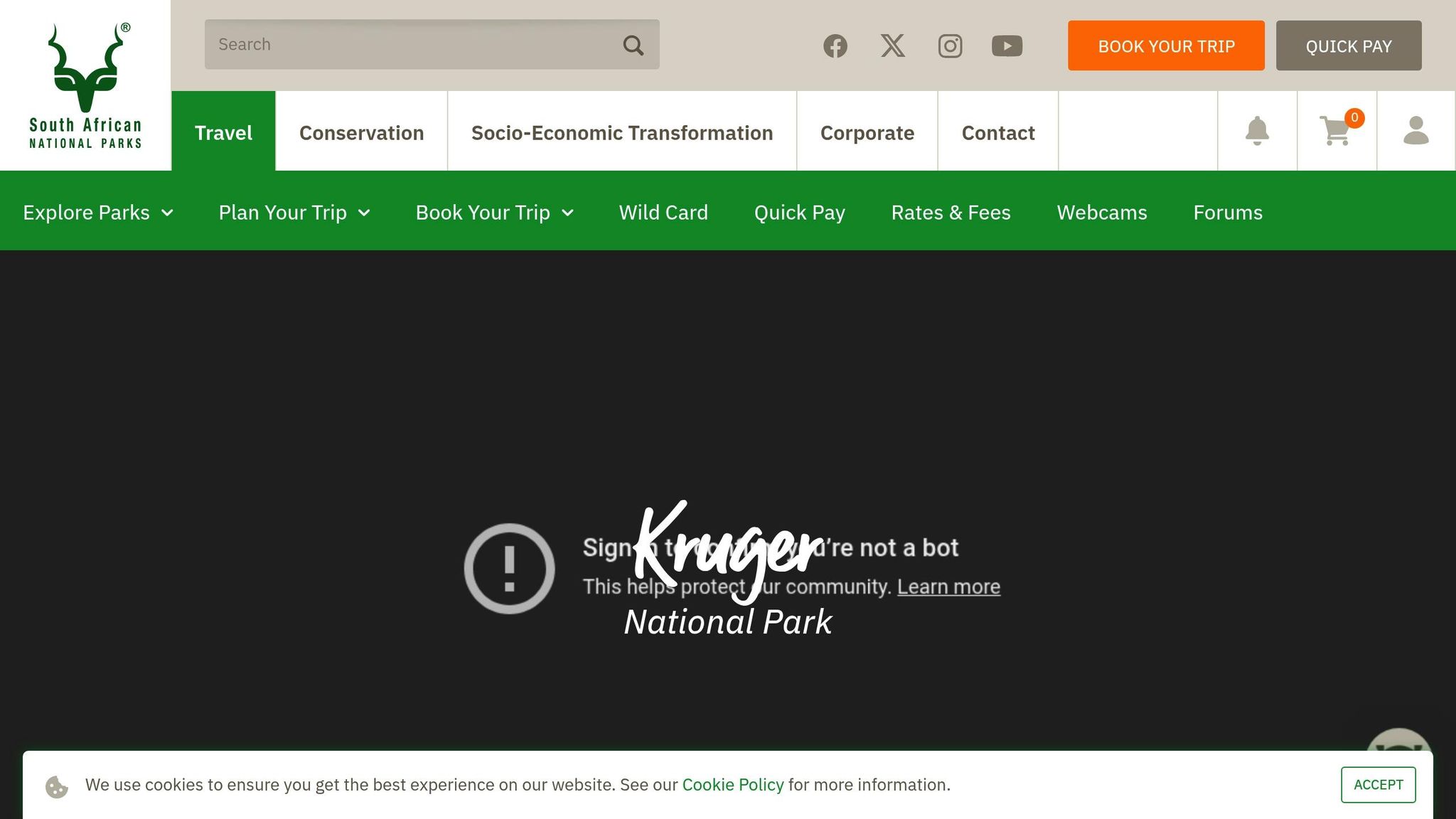
January in the southern part of Kruger National Park offers excellent summer wildlife viewing, even with temperatures climbing to 95°F (35°C). The key is timing – animals gather at waterholes during the cooler hours of early morning and late afternoon.
The southern region, stretching from Lower Sabie to Crocodile Bridge, is home to a variety of species, including the iconic Big Five: lions, leopards, elephants, rhinos, and buffalo. To maximize your sightings, check out these routes:
Top Wildlife Drives:
- Lower Sabie to Skukuza (H4-1): This 27-mile (43 km) stretch along the Sabie River is perfect for spotting hippos and crocodiles.
- Crocodile Bridge to Lower Sabie (H4-2): An 18-mile (29 km) route known for frequent lion and leopard sightings.
- S28 (Crocodile River Road): A gravel road running alongside the Crocodile River, offering great opportunities to see elephant herds.
Driving Conditions: Keep in mind that January thunderstorms can make dirt roads slippery or even close them. However, main roads (H-roads) remain open and accessible year-round.
Wildlife Watching Tips:
- Start your drives early – gates open at 4:30 AM during summer.
- Focus on waterholes between 6:00–9:00 AM.
- Plan afternoon drives from 4:00–7:00 PM for another chance to see active wildlife.
- Check out predator hotspots like Nkuhlu Picnic Site and Sunset Dam.
Weather Notes: The southern region experiences high humidity and frequent afternoon showers, with an average rainfall of 3.5 inches (90 mm) in January.
| Time of Day | Average Temperature | Wildlife Activity |
|---|---|---|
| Early Morning (4:30–8:00 AM) | 68-77°F (20-25°C) | High |
| Mid-day (10:00 AM–3:00 PM) | 86-95°F (30-35°C) | Low |
| Late Afternoon (4:00–7:00 PM) | 77-86°F (25-30°C) | High |
Pack essentials like water, sunscreen, and lightweight, breathable clothing. If you plan to explore dirt roads, a 4×4 vehicle is highly recommended.
2. February: Addo Elephant National Park
February brings warm summer days to Addo Elephant National Park in the Eastern Cape, offering plenty of opportunities to see elephants and enjoy well-laid-out wildlife viewing routes.
Top Wildlife Drives:
- Main Game Area Circuit: This 12-mile (19 km) loop includes Hapoor Dam, a hotspot for elephant herds during the midday heat.
- Gorah Loop: Covering 8 miles (13 km), this route is ideal for spotting buffalo and zebras.
- Mbotyi Loop: A shorter 6-mile (10 km) drive with scenic views of the Zuurberg Mountains and frequent black rhino sightings.
Best Viewing Times:
- Early Morning: 5:30 AM – 9:00 AM
- Late Afternoon: 4:00 PM – 7:00 PM (park closes at sunset)
Wildlife is most active during these cooler hours, making them the best times for a successful drive.
Weather and Driving Conditions:
The park’s main roads are paved and suitable for standard vehicles. However, red clay roads can become slippery after rain, so drive cautiously.
| Time Period | Temperature | Wildlife Activity | Road Conditions |
|---|---|---|---|
| Morning | 65–72°F (18–22°C) | High | Excellent |
| Midday | 81–86°F (30°C) | Moderate | Good |
| Afternoon | 77–81°F (25–27°C) | High | Variable (weather dependent) |
Important Tips for Visitors:
- Park gates open at 5:30 AM during summer, with the last entry allowed at 4:00 PM.
- Fuel is available at the main camp.
- A 4×4 vehicle isn’t needed for main routes.
- Bring at least 1 gallon (3.8 liters) of water per person.
- Stick to marked roads – off-road driving is not allowed.
- Keep a distance of at least 50 yards (46 meters) from animals.
- Waterholes are excellent spots to check during the hottest parts of the day.
Plan your visit to make the most of these prime conditions and unforgettable wildlife encounters.
3. March: Hluhluwe-iMfolozi Park
March brings autumn to Hluhluwe-iMfolozi Park, offering mild temperatures and thinning vegetation that make it easier to spot wildlife. Known as Africa’s oldest nature reserve, the park is celebrated for its rhino conservation efforts. This seasonal change improves both the quality of game drives and the chances of seeing active animals.
Top Wildlife Drives:
- Hilltop to Mpila: A 15-mile (24 km) scenic route featuring diverse landscapes where you can often find white rhinos and elephants.
- Sontuli Loop: An 8-mile (13 km) grassland drive, ideal for spotting lions hunting during the early morning hours.
- Memorial Gate Circuit: A 12-mile (19 km) route with multiple waterholes, perfect for observing nyala and other wildlife.
Weather and Driving Conditions:
| Time of Day | Temperature | Wildlife Activity |
|---|---|---|
| Dawn | 61-68°F (16-20°C) | Excellent |
| Midday | 77-82°F (25-28°C) | Moderate |
| Dusk | 70-75°F (21-24°C) | High |
Visibility is consistently good throughout the day, making it a great time for wildlife enthusiasts.
Essential Visitor Information:
- Park gates open at 6:00 AM, with the last entry allowed at 3:30 PM during March.
- Main roads are suitable for 2WD vehicles.
- Fuel is available at Memorial Gate and Hilltop Camp; night drives must be booked at least 24 hours in advance.
- Bring at least 1 gallon (3.8 liters) of drinking water per person.
- Keep windows closed near baboon troops and maintain a 65-yard (60 m) distance from all animals.
Best Viewing Spots:
- Mpila Lookout for buffalo herds.
- Sontuli Plains for zebra and wildebeest.
- Maphumulo picnic site for giraffe sightings.
- Thiyeni Hide for close-up rhino encounters.
Safety Guidelines:
- Stay inside your vehicle unless you’re in designated areas.
- Stick to marked roads.
- Maintain speeds under 25 mph (40 km/h).
- Avoid driving after sunset unless accompanied by a guide.
- Keep emergency numbers handy.
- Use the park map to log wildlife sightings.
March’s pleasant weather and reduced vegetation make it a fantastic time for wildlife photography and exploration.
4. April: Kgalagadi Transfrontier Park
April is a great time to explore Kgalagadi Transfrontier Park. With mild temperatures and stunning red dunes, the park offers excellent conditions for spotting wildlife. The 20-mile (32 km) Nossob River Valley route is a top choice for seeing gemsbok and springbok against the dramatic desert landscape. Another favorite is the 15-mile (24 km) Auob River Road, where visitors often see black-maned lions and cheetahs.
Key Wildlife Routes:
- Nossob River Valley Drive: Best for early morning antelope sightings.
- Auob River Road: Ideal for afternoon predator activity.
- Mata Mata Border Loop: Great for birdwatching and spotting smaller desert animals.
Viewing Tips:
- Start your drives early (gates open at 6:00 AM).
- Focus on waterholes between 7:00 and 10:00 AM for active wildlife.
- Plan afternoon drives between 3:00 and 6:00 PM.
- Bring binoculars to spot animals on distant dunes.
Weather Notes:
| Time of Day | Temperature | Wildlife Activity |
|---|---|---|
| Morning | 50-59°F (10-15°C) | High |
| Midday | 77-86°F (25-30°C) | Moderate |
| Evening | 59-68°F (15-20°C) | High |
As April transitions to May, think about visiting Madikwe Game Reserve, where seasonal changes bring fresh opportunities to see wildlife.
5. May: Madikwe Game Reserve
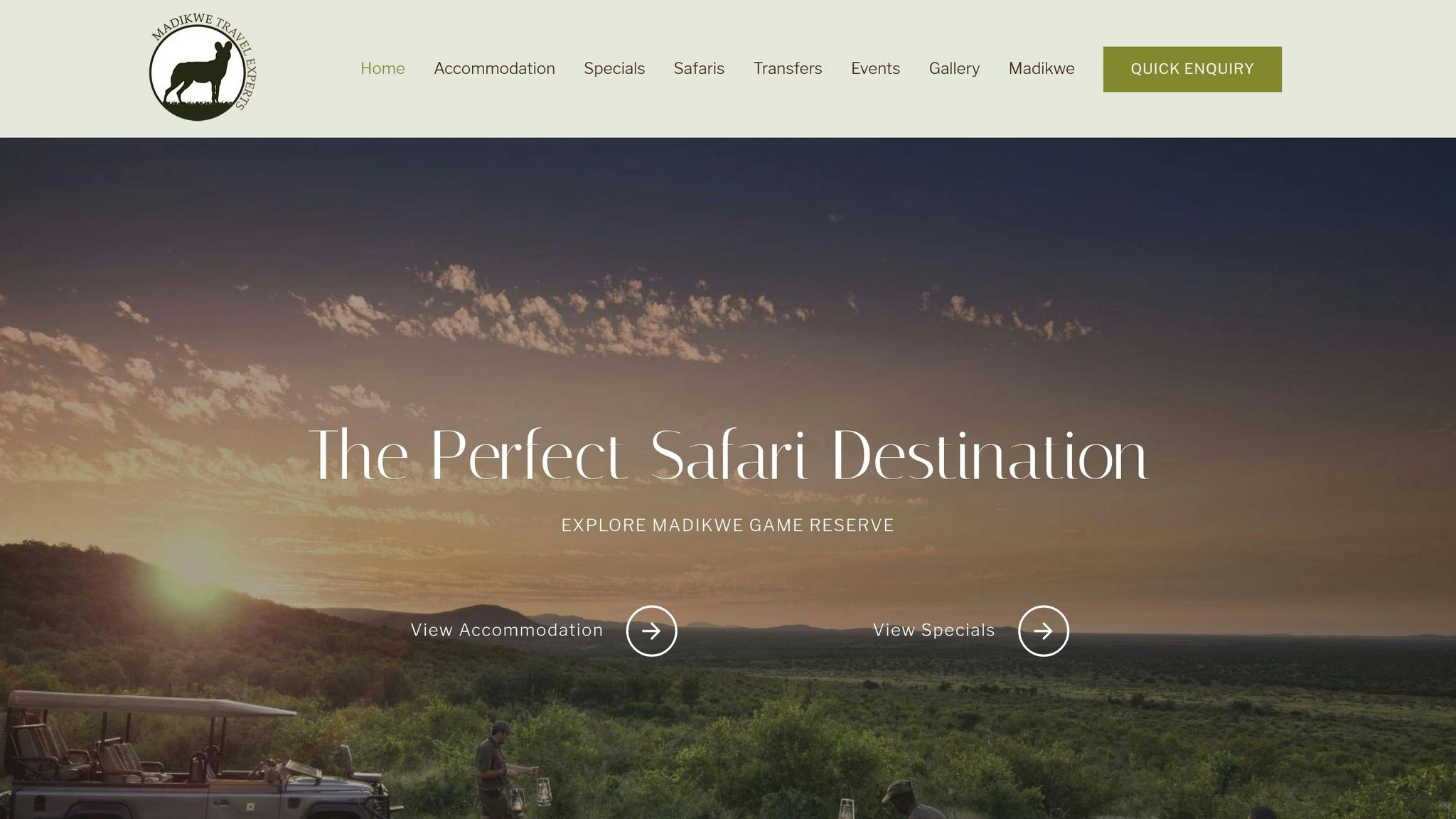
May signals the start of the dry season in Madikwe Game Reserve, making it an ideal time for wildlife viewing. Situated in South Africa’s North West Province, this 185-square-mile (480 km²) reserve is free from animal-borne diseases and offers plenty of chances to spot the "Big Five" – lions, leopards, elephants, rhinos, and buffalo.
Top Wildlife Routes
- Molatedi Dam Circuit: A 12-mile (19 km) route perfect for spotting elephants and buffalo in the morning.
- Tweedepoort Loop: An 8-mile (13 km) drive where lion and leopard activity is often observed.
- Derdepoort Valley: A 10-mile (16 km) scenic route, great for tracking rhinos.
Best Times for Viewing
| Time Period | Activity Level | Wildlife Focus |
|---|---|---|
| 6:00-9:00 AM | Very High | Predator hunting activity |
| 10:00 AM-2:00 PM | Moderate | Waterhole gatherings |
| 3:30-6:30 PM | High | Large herbivore movement |
Weather and Wildlife Behavior
May’s cooler temperatures make it comfortable for longer wildlife viewing sessions:
- Morning: 45-54°F (7-12°C)
- Midday: 68-77°F (20-25°C)
- Evening: 50-59°F (10-15°C)
With vegetation thinning out, animals are drawn to permanent water sources like those along the Marico River. The sparse foliage also provides excellent visibility for photography, especially during the soft light of early mornings and late afternoons.
Tips for a Successful Drive
- Stay at least 165 feet (50 meters) away from large predators.
- Stick to designated roads and tracks.
- Pack extra water and warm clothing for early morning drives.
- Use quality binoculars (10×42 magnification or better) for spotting distant wildlife.
The western section of the reserve is particularly active in May, as animals congregate around the remaining water sources. Plan your drives to cover both wooded and open savanna areas to maximize your chances of spotting a variety of wildlife. This mix of habitats sets the stage for even more exciting encounters as the season progresses into June.
6. June: Pilanesberg National Park
June brings the dry winter season to Pilanesberg National Park, making it easier to spot wildlife as the vegetation thins out.
Top Wildlife Routes
Scenic drives take you through diverse landscapes, from waterholes to open savannahs. These routes offer great chances to see elephants, big cats, and other animals up close.
Weather and Viewing Conditions
June mornings are cool, and afternoons are mild – perfect for wildlife spotting. With less foliage and limited water sources, animals tend to gather around the remaining waterholes, making them easier to find.
Tips for Planning Your Drive
To get the most out of your visit in June:
- Dress in layers to stay comfortable as temperatures change.
- Pack a thermos with a hot drink and bring quality binoculars.
- Book guided drives early to secure your spot.
Wildlife Photography Tips
- Use the soft light of early mornings and late afternoons for better photos.
- Position your vehicle with the sun behind you for ideal lighting.
- Keep a safe and respectful distance from the animals.
As July rolls in, Sabi Sand Game Reserve offers new opportunities for wildlife enthusiasts.
7. July: Sabi Sand Game Reserve
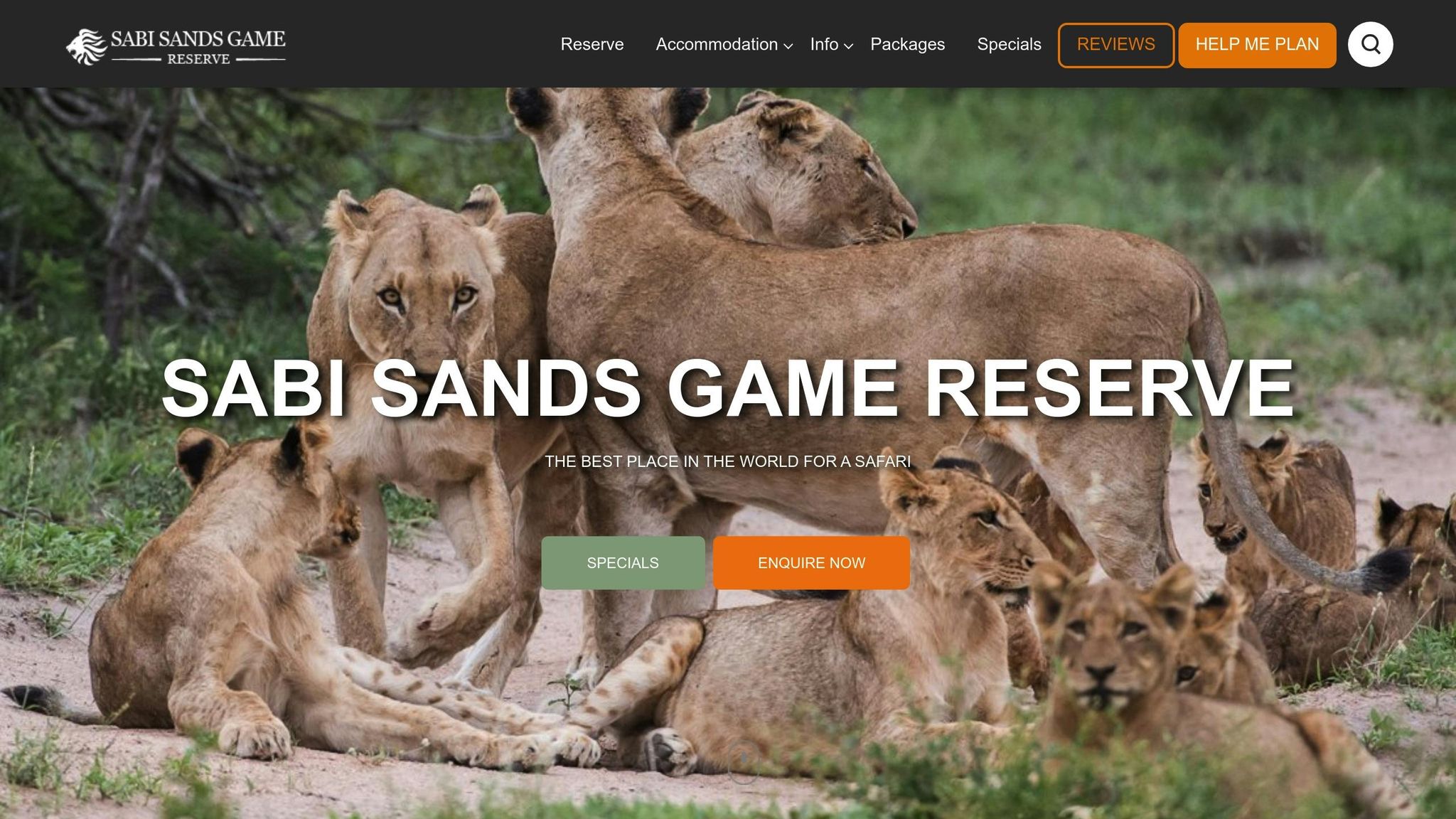
July in Sabi Sand means cooler winter days and an increased chance to see wildlife. With water sources becoming scarce, animals gather around waterholes, making early morning and late afternoon drives particularly rewarding.
Best Routes for Game Drives
The private roads in Sabi Sand are well-maintained, offering close-up wildlife experiences. Guides use their expertise to track animal movements, ensuring you’re in the right place at the right time.
Wildlife Highlights
Cool mornings are perfect for spotting predators on the hunt, while larger herds gather at permanent water sources later in the day. Early drives often reveal harder-to-spot species, and some nocturnal animals may still be active.
Why Choose a Private Guided Safari?
- Go off-road to follow animal tracks
- Limited vehicles at sightings ensure a quieter experience
- Guides coordinate to enhance your chances of seeing rare species
- Occasionally, enjoy special night drives
Tips for Wildlife Photography
The clear skies and low dust levels in July create fantastic lighting. Early mornings and the extended golden hours are ideal for capturing incredible shots, while clear nights are perfect for astrophotography.
Key Advice for Your Safari
- Start early to catch peak wildlife activity
- Dress in warm, layered clothing for chilly mornings
- Use high-quality camera gear with long-range lenses
- Stay for several days to maximize your encounters
Get ready – August brings new adventures at Marakele National Park!
8. August: Marakele National Park
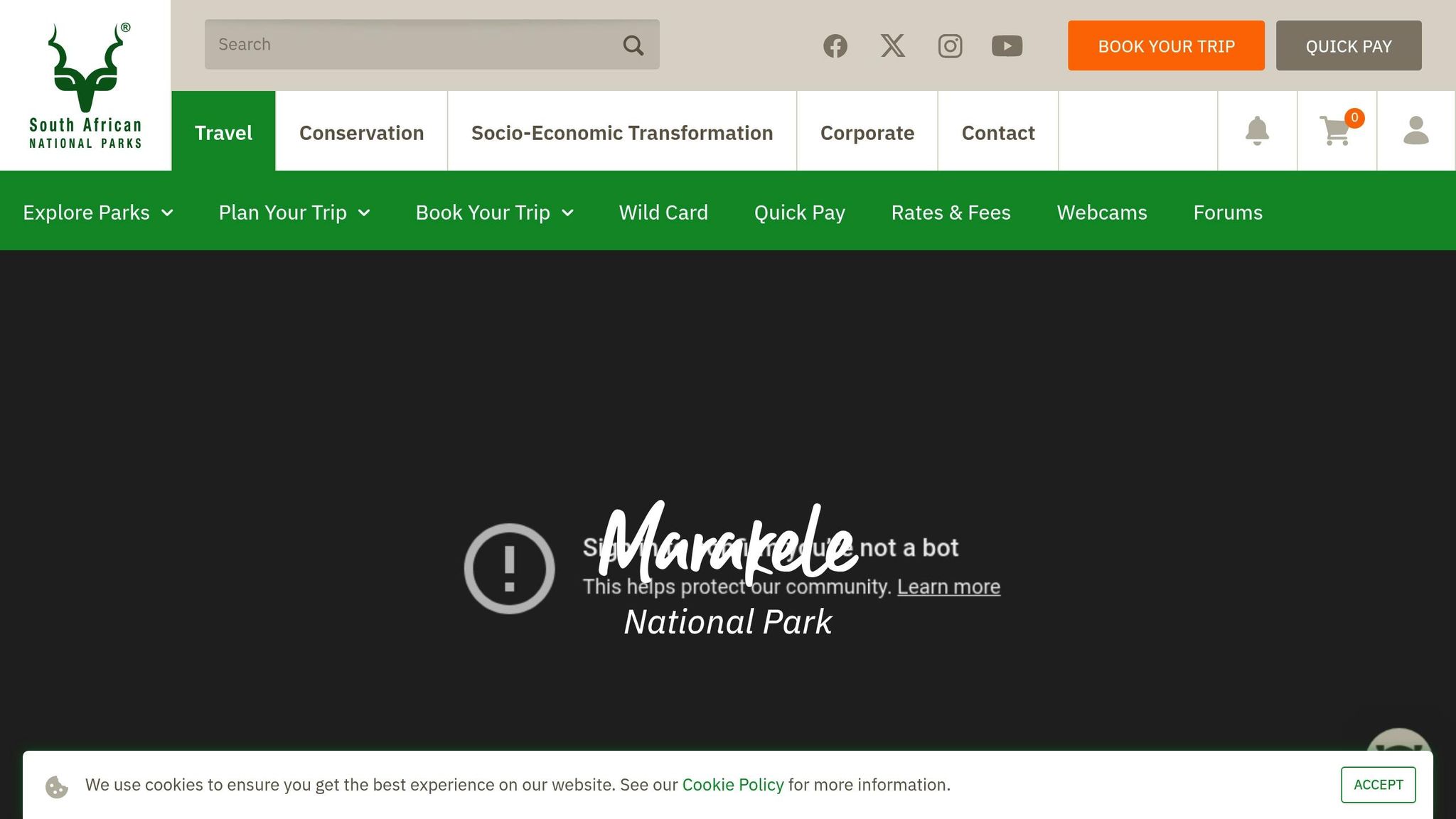
After the action-packed experiences of July at Sabi Sand Game Reserve, August brings a more serene escape to Marakele National Park. This destination offers a peaceful contrast to the high-energy wildlife encounters earlier in the year.
August is an ideal time to enjoy quiet drives through Marakele’s diverse scenery. While detailed route specifics for this month aren’t widely available, the park’s tranquil atmosphere makes it a relaxing choice. Be sure to prepare for changing conditions by outfitting your vehicle appropriately and staying updated with local park alerts.
sbb-itb-09752ea
9. September: iSimangaliso Wetland Park
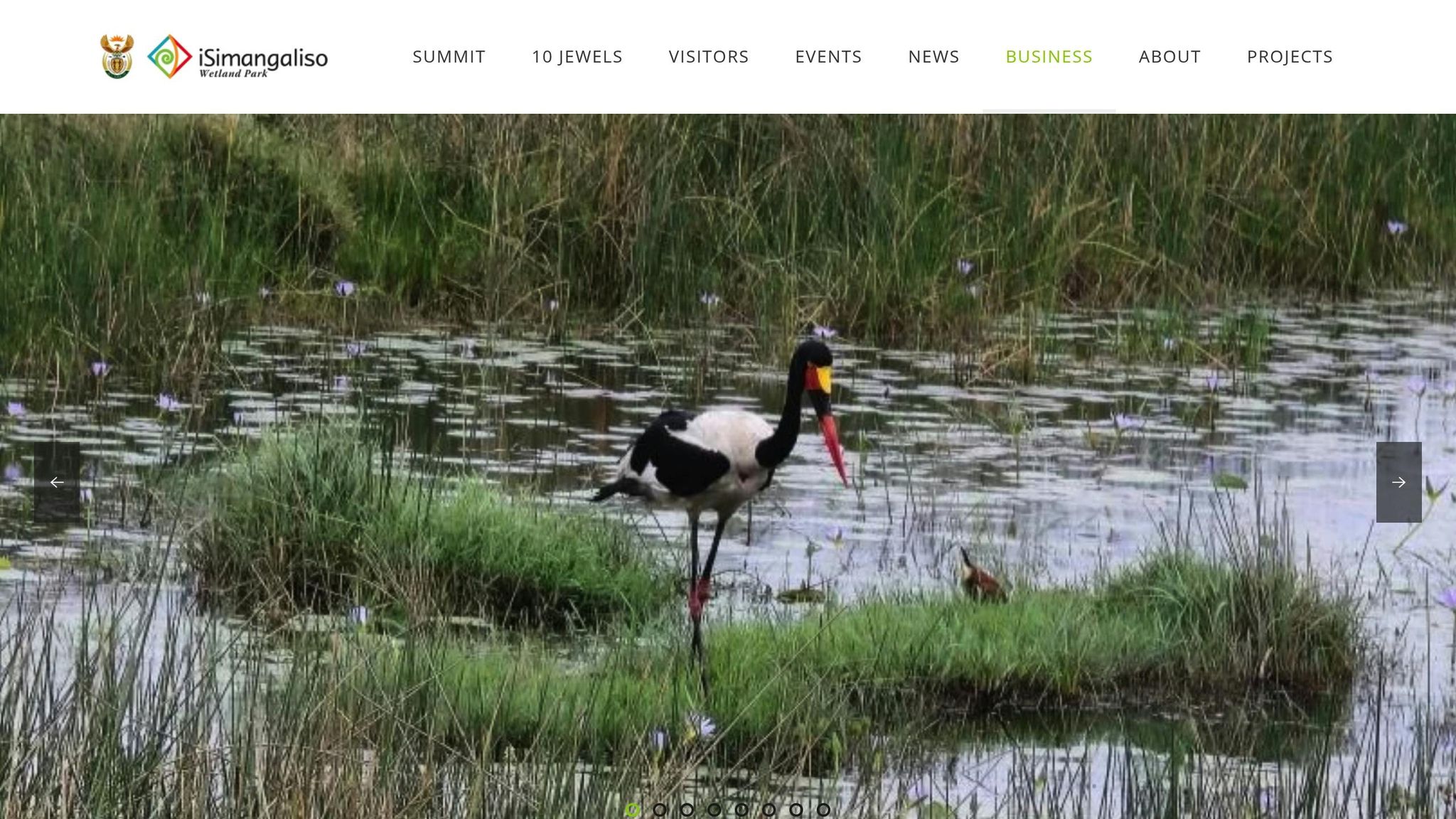
September is a great time to visit iSimangaliso Wetland Park, South Africa’s first UNESCO World Heritage Site. With spring bringing new life to its diverse ecosystems, the park offers an incredible mix of coastal and wetland scenery. Seasonal changes here influence wildlife activity, making your visit even more memorable.
You can explore the park through self-drive routes that take you through stunning landscapes. Keep an eye out for hippos, crocodiles, antelope, and a variety of bird species. For the best wildlife sightings, consider a morning drive through the wetlands or an afternoon trip along the coast. Up next, discover October’s scenic drives at Mountain Zebra National Park.
10. October: Mountain Zebra National Park
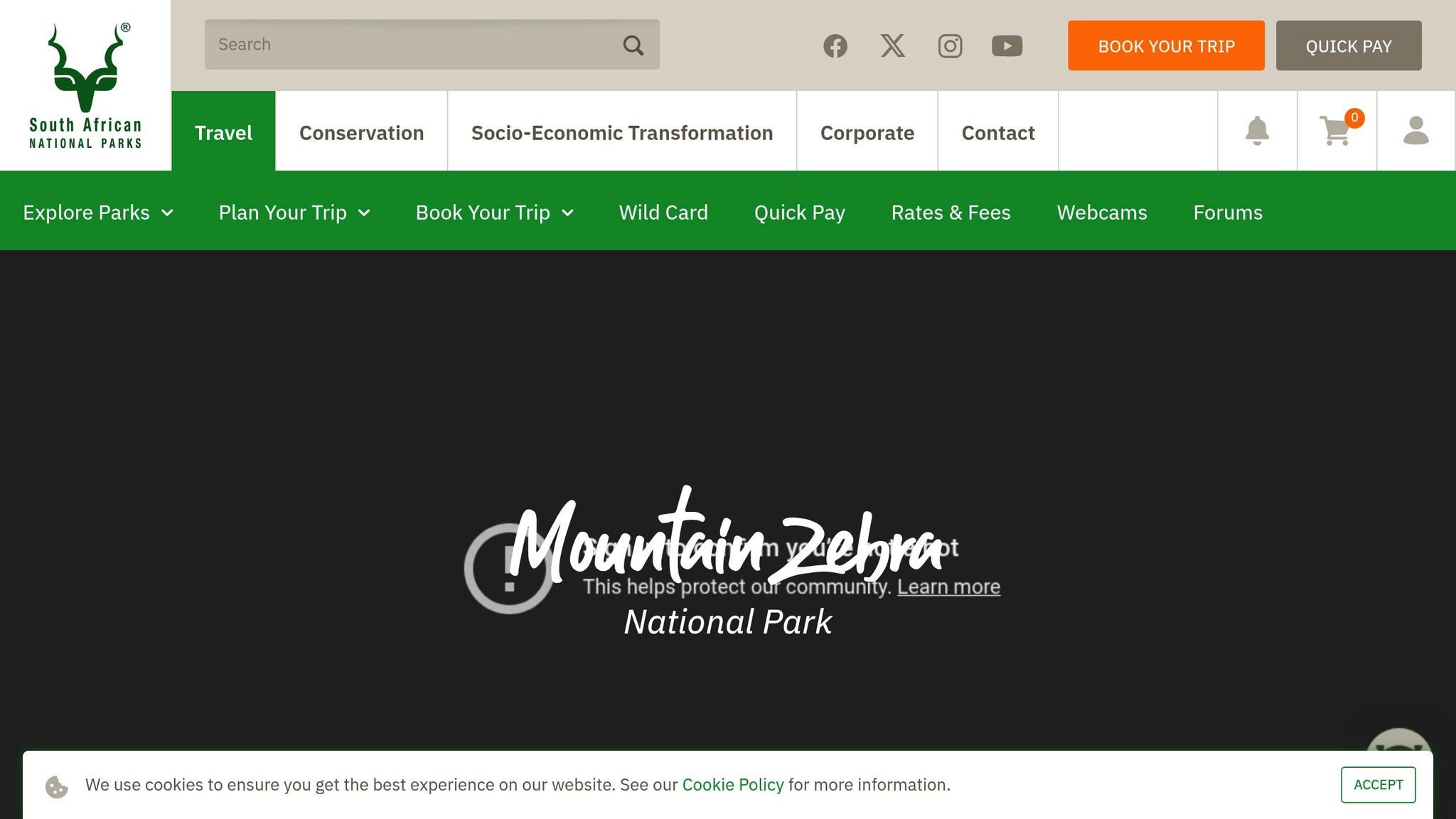
October brings pleasant mid-spring weather to Mountain Zebra National Park. The mild temperatures and lush scenery make it a great time to explore the park’s dramatic landscapes. Guided tours are a fantastic way to learn more about the park’s diverse wildlife and unique features. It’s the perfect setting for adventure as the season unfolds.
11. November: Karoo National Park
November is a great time to visit Karoo National Park. The late spring weather is mild, and the arid landscape starts to show signs of life, creating an inviting atmosphere for visitors. The self-drive routes are easy to navigate, offering an enjoyable way to explore the area. You’ll also spot more wildlife during this time, making it an excellent opportunity for both nature lovers and photographers to capture South Africa’s rural charm. Up next: the diverse scenery of Kruger National Park North in December.
12. December: Kruger National Park North
December is a great time to visit the northern part of Kruger National Park. The summer heat brings wildlife to water sources, making it easier to spot animals like elephants. The park is also quieter during this time, offering a more peaceful experience.
To increase your chances of seeing wildlife, schedule your drives early in the morning or late in the afternoon. This approach works well in December, just as it does in other months. Be sure to follow local safety guidelines during your visit.
For more tips on traveling through South Africa’s stunning landscapes, check out ImotoNews South Africa.
Major Parks and Reserves Guide
Here’s a quick overview of some of South Africa’s standout wildlife destinations:
Kruger National Park
Spanning a vast area, Kruger National Park is home to diverse ecosystems, from thick bushland to open savannas. It’s one of the best places to spot the Big Five.
Addo Elephant National Park
Addo Elephant National Park is famous for its thriving elephant population. It offers a mix of inland and coastal scenery, including bushveld and sandy coastal dunes.
Pilanesberg National Park
Located within an ancient volcanic crater, Pilanesberg features a mix of landscapes like waterholes, rocky hills, and open plains that attract a wide range of wildlife.
Madikwe Game Reserve
This malaria-free reserve is a haven for wildlife enthusiasts, with a variety of mammals and birds thriving in its unique vegetation zones.
Hluhluwe-iMfolozi Park
A leader in rhino conservation, Hluhluwe-iMfolozi boasts rolling hills, river valleys, and savannas that provide shelter for endangered species.
Sabi Sand Game Reserve
Adjacent to Kruger National Park, Sabi Sand is celebrated for its incredible big cat sightings, especially leopards.
Use this guide to plan your self-drive safari and explore South Africa’s rich and varied wildlife experiences. Each destination offers something special for nature lovers and adventurers.
Weather and Trip Planning Tips
Getting ready for your safari is key to making the most of it. Start by ensuring your vehicle is in top shape. Check the tires, brakes, and fluid levels, and schedule a mechanic to give it a thorough inspection ahead of time.
Stay updated on local weather forecasts and park advisories before heading out. Keeping an eye on conditions and updates will help you adjust your plans and ensure a safe and enjoyable trip.
Park Visit Comparison Chart
Here’s a quick reference guide highlighting South Africa’s top wildlife parks, the best months to visit, key animals to spot, and what each season offers:
| Park Name | Best Months | Key Wildlife | Seasonal Highlights |
|---|---|---|---|
| Kruger National Park South | January | Big Five; diverse bird species | Green season brings newborns and prime birdwatching opportunities |
| Addo Elephant National Park | February | Elephants; Cape buffalo; black rhino | Fewer crowds and pleasant temperatures (65–80°F) |
| Hluhluwe-iMfolozi Park | March | White rhino; nyala; wild dogs | Clear skies, light rain, and active predators |
| Kgalagadi Transfrontier Park | April | Black-maned lions; cheetah; raptors | Comfortable days (70–75°F) with excellent visibility |
| Madikwe Game Reserve | May | African wild dogs; lions; elephants | Dry season begins, making wildlife easier to spot |
| Pilanesberg National Park | June | Rhino; leopard; brown hyena | Crisp winter days with animals gathering at waterholes |
| Sabi Sand Game Reserve | July | Leopards; lions; elephants | Dry season peaks, offering great game viewing |
| Marakele National Park | August | Cape vultures; elephants; rhino | Cool mornings and clear, dry weather |
| iSimangaliso Wetland Park | September | Hippos; crocodiles; flamingos | Spring blooms and ideal whale-watching conditions |
| Mountain Zebra National Park | October | Cape mountain zebra; cheetah | Spring births and mild temperatures |
| Karoo National Park | November | Black rhino; kudu; mountain zebra | Vibrant spring vegetation and active nocturnal animals |
| Kruger National Park North | December | Big Five; diverse mammals | Lush summer landscapes after seasonal rains |
Keep in mind that rainfall and animal migrations can influence these timings. Always check with park authorities for updated conditions and specific viewing advice. For detailed routes and travel tips, revisit the individual park sections above.
Conclusion
Before heading out on a wildlife drive in South Africa’s parks, make sure your vehicle is in good condition and properly serviced. Whether you’re planning a summer trip to Kruger or a winter safari in Pilanesberg, every month brings its own special experiences in these parks. Refer to the monthly guide above and explore the travel tips on the ImotoNews South Africa blog to ensure a safe and unforgettable adventure.
FAQs
What is the best time of day to go on a wildlife drive in South Africa’s national parks?
The best times for wildlife drives in South Africa’s national parks are typically early morning and late afternoon. During these cooler parts of the day, animals are more active and easier to spot, especially predators returning from nighttime hunts or herbivores grazing in open areas.
In the early morning, you can enjoy breathtaking sunrises while catching animals near waterholes or on the move. Late afternoon drives offer the chance to witness the golden hour, which enhances the scenery and provides excellent photo opportunities. Avoid midday drives when temperatures are higher, as animals are more likely to rest in shaded areas, making them harder to find.
How does South Africa’s seasonal weather impact wildlife viewing and behavior in its parks?
Seasonal weather in South Africa plays a significant role in wildlife visibility and behavior, making certain times of the year better for game drives. During the dry winter months (May to September), animals are easier to spot as vegetation thins out and wildlife congregates around water sources. This is especially true in regions like Kruger National Park and the Kgalagadi Transfrontier Park.
In contrast, the summer months (October to April) bring lush greenery and newborn animals, offering a different kind of beauty. However, wildlife may be more spread out due to abundant water, and the heat can make some animals less active during the day. Regardless of the season, South Africa’s parks offer unique experiences year-round, making it a top destination for wildlife enthusiasts.
Do I need a 4×4 vehicle to explore South Africa’s top wildlife parks?
A 4×4 vehicle is not always necessary for visiting South Africa’s wildlife parks, but it can be very helpful in certain situations. Many major parks, such as Kruger National Park, have well-maintained roads that are accessible with a standard car. However, if you’re planning to explore remote areas, smaller reserves, or less-traveled routes, a 4×4 is recommended for better traction and safety.
Before your trip, check the specific park’s road conditions and weather forecasts, especially during the rainy season, as some dirt roads may become challenging to navigate without a 4×4.
Related posts
- Fuel-Saving Tips for Long South African Road Trips
- 7 Winter Car Care Tips for South Africa
- SA’s First Solar EV Charging Stations: What to Know
- 5 Romantic Coastal Drives in South Africa





